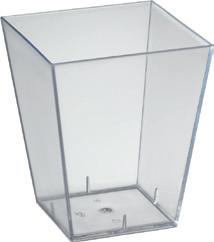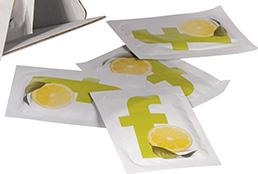

FOODSERVICE 2024





• No need to fold boxes or lids
• Modular, stackable and microwarmable
• Tapered edges ensure great leak-resistance
• Expand when filled for tight-fitting lid






CARDBOARD/PE BASIC SOUP BOWLS


















FIXPACK®
• Sturdy
• Lids fit multiple containers
• Suitable for hot food












DELIPACK
• Round Delipack can be sealed with Duniform® machine DF5.
• Lids fit multiple containers
• Great stackability using lid closure



SUSHI & LUNCH BOXES
• High lid for great food protection
• Hinged lid
Material: PS max +100°C
PP max +100°C
1 170307 Lunch Box Black/Transparent
2 172632 Lunch Box Black/Transparent PS
3 127803 Lunch Box White/Transparent





Passionate

OCTAVIEW® COLD USE
• Contemporary design language
• Top-quality APET material
• Crystal clear hinged lid
• Secure closing with haptic click
• Smart stack system
Material: APET max +70°C













OCTAVIEW® COLD USE
• Hinged lid
• Tear-off function on selected boxes*
• Suitable for cold food
• Secure dressing glass in selected boxes
Material: PS max +70°C






















OCTAVIEW® & OCTABOWL® HOT USE
• Hinged lid
• Suitable for hot food
• Lids with tear-off function

DUNI GOURMET® HOT USE
• Suitable for hot food
• Excellent shelf display
• Crystal clear lid




MEAL BOXES
• Suitable for hot food
• Venting holes in the lid for steam release
• One lid fits all
Material: PP max +120°C (microwarmable)
3 161181 Lid for 161182/161179




SOUP BOWLS
• Handles to prevent burned hands
Material: PS max +100°C (microwarmable)
PP/MIN max +120°C (microwarmable)
PP max +120°C (microwarmable) No.





DESSERT BOWLS
• Superb transparency





• Superb transparency






TAKE-AWAY PAPER AND POCKET
• Trendy
• Convenient on-the-go solution
• Grease resistant
Paper/PE max +70°C






DUNI AMUSE-BOUCHE®
• Eye-catching design
• Superb transparency
Material: PS max +100°C
PET max +70°C






DUNI AMUSE-BOUCHE®
• Eye-catching design
• Superb transparency
Material: PS max +100°C

DUNI
AMUSE-BOUCHE®
• Ideal for larger events, value packs simplify handling
• Conveniently packed
• Fits to Duni Amuse-bouche display solutions
Material: PS max +100°C


DUNI AMUSE-BOUCHE®
• Safe transport
• Modular system
• Perfect for pre-packed offers
Material: Cardboard/PE window max +100°C






TREND GLASSES











PREMIUM GLASSES
• One-piece glasses – no assembly needed
PS max +100°C





GLASSES
FESTIVAL GLASSES
• Flexible material to avoid breakage











CIRCUIT COFFEE-TO-GO CUPS
• Cost-effective solution for design lovers
• Sizes for every need with matching PS lids
• PE lamination
• Reclosable flip plug prevents leaks







CAFÉ IZZA CUPS
• Matching FSC®-certified napkins available
• Vented lids








COFFEE QUICK CUPS










HOT DRINK CUPS

PLASTIC COFFEE CUPS



VENDING PLASTIC CUPS






CONDIMENTS



















COOKING BAGS
• Suitable for sous-vide cooking
Material: PE max +120°C
1 162016 Cooking Bag, 1,5l Transparent 200x300 1x1000
2 162017 Cooking Bag, 2,5l Transparent 250x350 1x1000
3 162018 Cooking Bag, 6,0l Transparent 320x450 1x500
4 162019 Cooking Bag, 10,5l Transparent 350x550 1x500
PLASTIC, ALUMINIUM FOIL AND DISPENSERS
Material: ALU max +250°C
PE max +100°C
PVC max +100°C




2 716100 Pre-perforated Clingfilm (1100pcs)
3 716500 Clingfilm in Dispenser Box with Cutter
4 716600 Clingfilm in Dispenser Box with Cutter
6 716620 Clingfilm in Dispenser
7 717103 Dispenser for Clingfilm & Foil
8 719200 Foil in Dispenser with Cutter
9 719400 Foil in Dispenser with Cutter
10 719210 Refill Foil to Dispenser Box with Cutter ALU
11 719410 Refill Foil to Dispenser Box with Cutter




WHAT IS A CARBON FOOTPRINT?
Carbon footprint is used to describe the climate impact of a product over its entire life cycle. A calculation is made based on, e.g. type of material of the product, the energy used in manufacturing, transport, use phase and end-of-life handling.
The carbon footprint should be used with care since it is a simplified study of a complex reality. It does not describe the problem of plastics in the sea or use of chemicals and is dependent on facts like type of energy used and waste handling infrastructure.
A plant-based product may theoretically reach a zero carbon footprint when only renewable energy is used in the chain. A fossil-based plastic does not have this potential.
PRODUCTS
For packaging material the carbon footprint of the product is consistently lower than for the goods they protect. For plastic products, the transport is typically less than 10% of the overall footprint, also when shipped from China to Europe.
Calculations show that for Duni products for the same use, bagasse and paper products have the lowest carbon footprint.
RESEARCH BASED
There are numerous studies that calculate the carbon footprint according to the ISO standard ISO 14044. There are databases to give the average findings of these studies. The numbers shown are calculated by an independent partner, South Pole.
Carbon dioxide emissions from a Duni product life cycle are typically divided into:
Recyclability of Duni materials:
DISCOVER OUR CARBON FOOTPRINT TOOL
For more than a decade we have been constantly improving our offer of more sustainable packaging, with the goal of lowering our carbon footprint. We are focused on the larger picture of a product’s life cycle. Part of the focus will be on developing the material of the product, plant-based alternatives and resource efficiency, for example. The other part of the focus will be on different end-of-life options, composting is an example when it’s a relevant alternative. We are constantly looking for new ways to improve and innovate the full life cycle of our products so that the beginning and end of the life cycle are in line with more sustainable solutions.
We help you with the calculation of your carbon footprint for your take-away packaging choice, also considering different end-of-life options depending on different recycling streams in your country.
Get in contact with us if you would like help with figures to be used in communication with your customers.

Contact us for more info
CO2-calculator@duni.com


MATERIALS GUIDE
Different materials suit different needs. This guide will help you to make the right choice for your business.
APET -40°C to +70°C
Cardboard -20°C to +100°C
CPET -40°C to +220°C
HDPE -4°C to +100°C
Virgin plastic, amorphous poly(ethylene terephthalate)
Cardboard from forest fiber
Virgin plastic, crystalline poly(ethylene terephthalate)
Recycle as Plastics
Recycle as Paper/Carton
Recycle as Plastics
Virgin plastic, polyethene Recycle as Plastics
LDPE -4°C to +100°C Virgin plastic, polyethene
Recycle as Plastics Mineral
-20°C to +120°C Virgin plastic, polypropene with chalk or talcum
*Check specific temperature and time recommendation in catalogue
Recycle as Plastics
THE LIFECYCLE OF A DUNI PRODUCT
The life of a Duni product starts with the choice of material. We prefer renewable raw materials from trees and plants, which are responsibly grown and sourced. Leftover materials such as sugarcane fibres or recycled plastics are also a great way to upcycle and save resources.
Conscious convenience is a good reason to choose and use Duni products. We work hard to ensure good working conditions and limited environmental impact at our own and our suppliers’ manufacturing sites.
At the end of their life, Duni products should be recycled, composted or incinerated for energy efficiency. Littering is never an alternative and landfill should be avoided. We strive to enable good waste handling alternatives of our products.
SYMBOLS GUIDE
Designed for optimal stackability.

Oven safe.
Leak resistant.
Microwave safe.
Lid or sealing film does not mist up.
Hinged lid tears off easily.
Can be sealed by a Duniform® machine.
Can be customised with a logo, design or message.
Excellent insulation properties.

